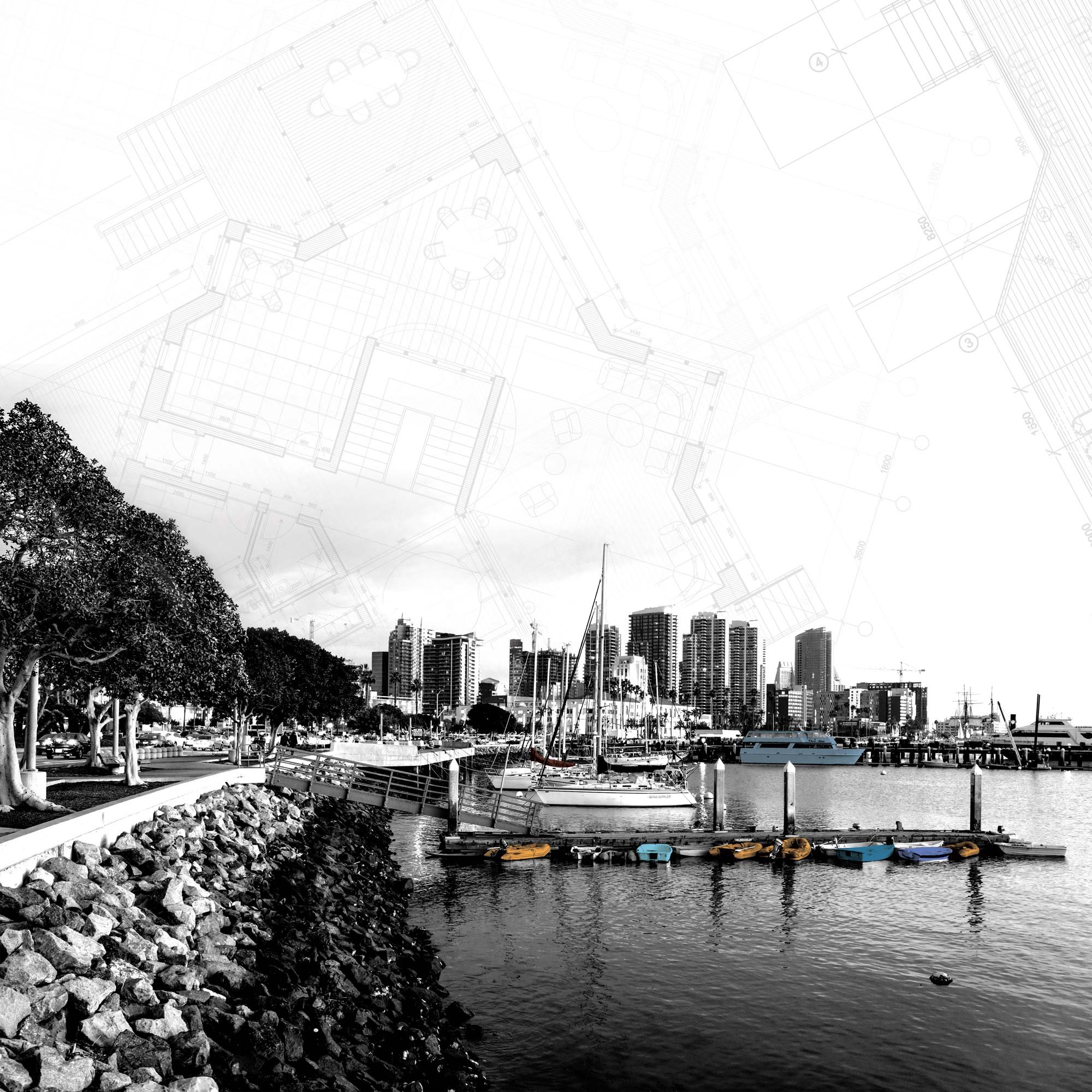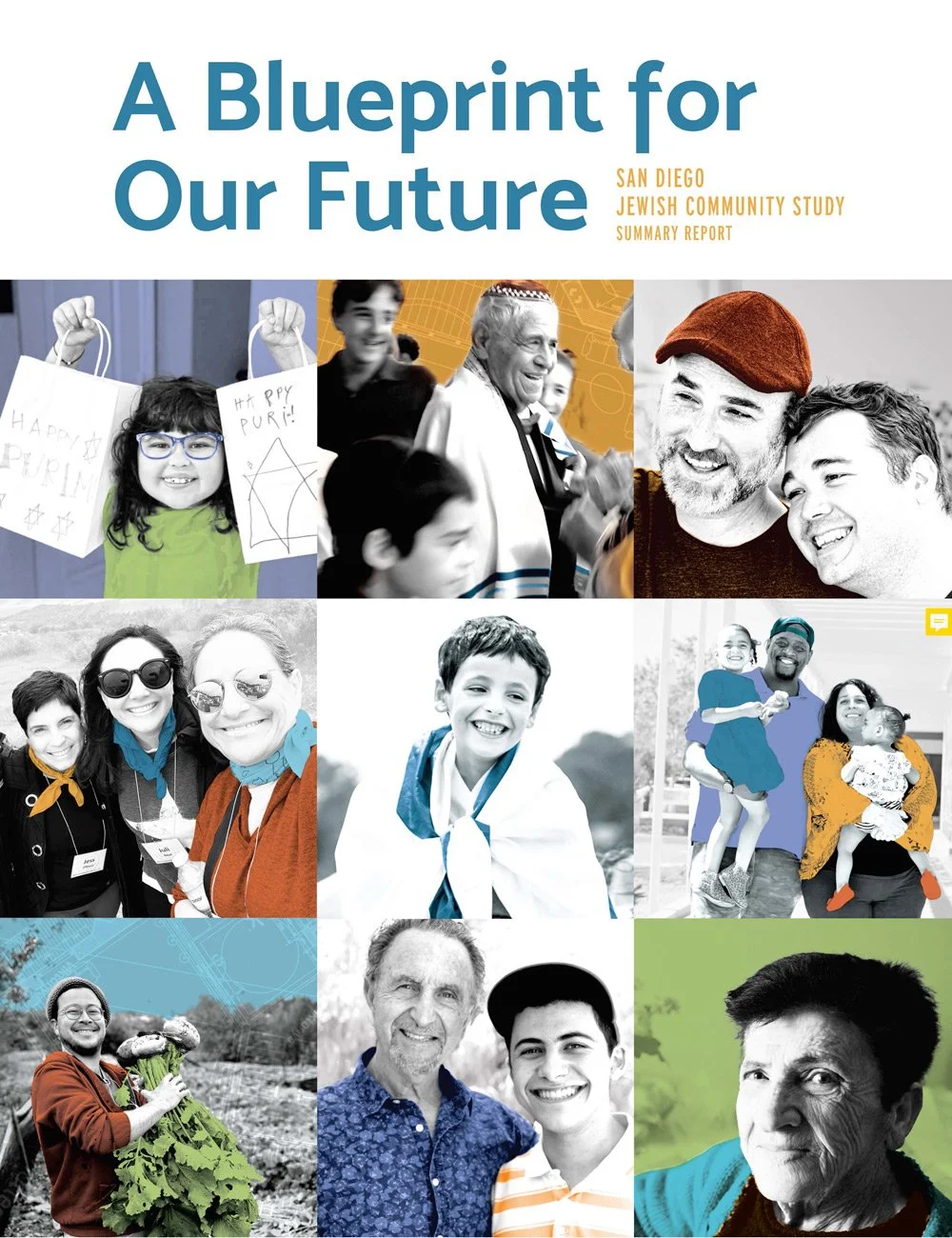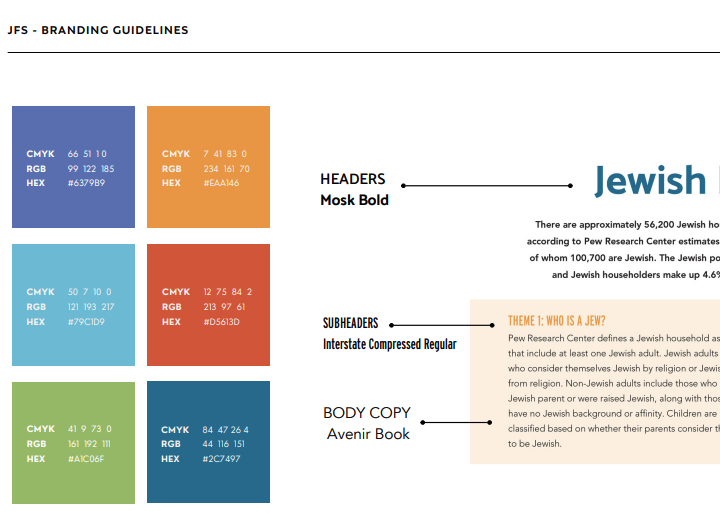
A Blueprint for Our Future
San Diego
Jewish Community Study
FAQS
Frequently Asked Questions
-
The Center for Modern Jewish Studies, at Brandeis University, the organization that conducted the San Diego community study, states that “local Jewish community studies are designed to help local Jewish agencies learn about the demographics of their communities; community members’ interest in services, affiliations with Jewish organizations, behaviors and attitudes; and a host of other topics that inform communal planning. The results of such studies help local Jewish organizations make informed, data-driven decisions about programming, resource allocation, goals and the impact of their efforts.”
-
Just as individuals change over time, so too do communities. Who makes up the community, where they live, how people behave, what they think, and much more, all change over time. The information provided in a community study is important for decision makers, community planners, and program organizers to base their actions on data, not anecdote, opinion or speculation. A community study provides the empirical data to help take advantage of today’s opportunities and prepare for tomorrow’s challenges. It is important to remember, that a community study in a snapshot in time of an ongoing and dynamic process. It is not a predictor of the future. This is precisely why the community study is called “A Blueprint for Our Future.” The results of a community study are useful for about ten years, which is why they need to be repeated periodically.
-
Commonly referred to as “the community study,” the official name of the community study is “A Blueprint for the Future: The 2022 San Diego Jewish Community Study.”
The 2022 San Diego Jewish Community Study provides a snapshot of today’s Jewish population in San Diego and considers trends and developments that diverge from those of the past. It is important to remember that it is not a predictor of the future. It is precisely because the study provides the actionable data necessary to support and drive our programming, and to ensure that our programs are responsive to community needs, that the study is called “A Blueprint for the Future.” Valid data are essential to effective decision making, allocation of resources, strategic priorities, community support, robust participation, and outreach, and the community study is our source of the most valid data about our community.
A Blueprint for our Future: The 2022 San Diego Jewish Community Study was conducted by the Maurice and Marilyn Cohen Center for Modern Jewish Studies (CMJS) at Brandeis University, in partnership with the National Opinion Research Center (NORC) at the University of Chicago.
A Blueprint for the Future is a starting point for introspection, deeper conversation, and collaborative community planning.
-
This report is based on data collected from 2,104 Jewish households in San Diego between June and September 2022. Survey respondents were randomly selected from all eligible households in Greater San Diego (including Temecula).
To identify who to include in the survey, the researchers initially utilized databases available from the study’s sponsoring organizations. Additionally, the study team contacted a wide variety of organizations in the community and asked them to share their membership lists for inclusion in the study. About thirty organizations participated representing a broad cross-section of the community, including synagogues, day schools, early childhood centers, cultural centers, community groups, social service agencies, and youth organizations.
These lists provided the researchers with known members of the Jewish community. To identify non-engaged and non-known Jews, lists of likely Jews were obtained from NORC and the US Postal Service Computerized Delivery Sequence File (CDSF), to ensure broad coverage of the Jewish community in Greater San Diego.
As a result of these efforts, the study’s total sample included 227,739 households in 158 zip codes. Households were contacted by mail, email, and telephone, and invited to complete the survey online or by telephone. Any household in the sample was considered eligible if it contained at least one adult aged 18 or older who lived in Greater San Diego for at least part of the year and considered himself or herself to be Jewish. This is how the researchers were able to identify the 56,200 households identified as Jewish.
-
Demographic research is a science. Using established and proven statistical modeling and stratified random sampling, researchers can achieve a 95% confidence interval (+/- 3%) by completing 1,004 randomly selected surveys. National presidential elections can be accurately predicted with 95% confidence by completing only 1,004 surveys. The researchers conducting the San Diego Community Study completed 2,104 surveys, more than twice needed to achieve, and ensure, a 95% confidence interval (+/-3%).
Obtaining a larger sample size, as the researchers did with the San Diego community study, is important because it reduces the survey’s margin of error and allows the researchers to better understand sub-populations (such as the financial security of single parents).
-
The community study’s principal goal is to provide the most up-to-date, comprehensive, and valid data about the San Diego Jewish community that can be used by communal organizations and their leadership to design programs and policies that support and enhance Jewish life.
Specifically, the study sought to:
Estimate the number of Jewish adults and children in the community and the number of non-Jewish adults and children who are part of those households,
Describe the community in terms of age and gender, geographic distribution, economic well-being, and other sociodemographic characteristics,
Measure participation in and attitudes toward community institutions, programs, and services,
Understand the multifaceted cultural, communal, and religious expressions of Judaism that constitute Jewish engagement,
Understand the diversity of the community in terms of race and ethnicity, age, country of origin, religious identity, LGBTQ+, and more,
Gauge current and potential need for human services, particularly for community members who are struggling financially.
-
From the very beginning, the study was driven by these guiding principles:
Gather actionable and usable data that sheds light on what Jews in San Diego think and feel.
Recognize the diversity of the Jewish community and use and inclusive lens when recognizing Jewish identity.
Ensure the full representation of Jews that are living on the margins and struggling to make ends meet.
Identify and understand Jews that are disengaged and/or disconnected from Jewish life.
-
A copy of the study’s main and summary reports can be found at: https://www.sdjewishblueprint.org/
-
Understanding the community study can offer numerous benefits, both personally, to your organization, and for the broader community. Here are several reasons why you might be interested:
Understanding Your Community: The community study provides insight into the dynamics, challenges, strengths, and opportunities of our San Diego Jewish community. It helps you understand the demographics, culture, patterns of behavior and engagement, and social structures that shape our community's identity.
Identifying Needs and Opportunities: By better understanding our community, you can identify its needs and opportunities for growth and development. This understanding can guide the allocation of resources, planning of initiatives, and implementation of programs to address specific issues or leverage potential areas of improvement.
Building Relationships: Opportunities identified in, and through, the community study, can foster relationships with fellow community members, leaders, and stakeholders. These connections can lead to collaborations, partnerships, and collective action toward common goals, fostering a sense of belonging and cohesion, and further building our Jewish community.
Informing Decision Making: The community study can provide valuable data and insights that may inform decision-makers to design effective interventions and allocate funding that address community needs and priorities.
Promoting Inclusion and Equity: Community studies often highlight disparities and inequities within communities, shedding light on issues related to poverty, identity, sense of inclusion or belonging, and access to resources. The community study provides information on how included our various community members feel, and what makes them feel more engaged.
Promoting Personal Growth and Learning: Studying and understanding the community study offers opportunities for personal growth and learning. It allows individuals, especially leaders and decision-makers, to develop their own analytical and critical thinking skills while gaining a deeper understanding of the complexities and nuances of our community.
Contributing to Positive Change: The data contained in the community study can serve as a catalyst for positive change, empowering individuals and groups to work together toward a shared vision of a thriving, inclusive, and resilient community.
There are many reasons to be interested in studying and understanding the San Diego Jewish Community Study. By investing time and effort in understanding the community study, you can contribute to building a stronger, more vibrant San Diego Jewish community that benefits everyone.
-
The Blueprint for the future community study is meant to provide decision makers and program developers with the empirical data they need to make decisions to better serve their organizations and our community. That may be to review the relevance and impact of existing programs, expand existing or develop new programs, or to identify other areas of further inquiry.
The Blueprint provides community organizations with the information they can use as their starting point for planning for the future.
-
Readers should use the information in the community study to support, validate, and reinforce, their programs, or to ensure that their established programming are addressing and responding to community needs and circumstances. Upon studying the Blueprint For Our Future, readers may also become aware of new programming opportunities, or areas that may require new inquiry or research.
-
The community study contains A LOT of information about many different facets of Jewish life, from demographics and geography, to community engagement and philanthropic giving. Initially, all the data may seem confusing.
Here are some guidelines for how to navigate and use the study:
Remember, the community study is only a snapshot in time. It is not a predictor of the future.
The goal is to gain insights, not trivia.
Do not be distracted by any single data point. Data is just trivia, and you cannot make decisions using just trivia. Connect data points to start building your ‘findings.’
Look at 4-5 data points and build a narrative. What’s going on? What do you see in the data that makes you say that? When you start to put your findings into context, then you begin to have insights, and you need insights to make decisions.
Reading the study may provide you with insights about new opportunities you might not have been aware of previously, or provide you with the data you need to support or modify an existing program, or start at new program.
A useful and productive approach is to start with a question, or problem, you’re trying to solve. Refer to the study to provide you with the data, findings and insights you need to answer your question, or address your problem.
“If I had an hour to solve a problem and my life depended on the solution, I would spend the first 55 minutes determining the proper question to ask… for once I know the proper question, I could solve the problem in less than five minutes.” Albert Einstein
Most importantly, approach the study and the data with a positive mind. If you see something seemingly disconcerting, what can we do? Remember, the study is not a predictor of the future.
Finally, reviewing the study might also prompt you to become aware of issues that might require more research. These insights are important because they will drive our ongoing research efforts in our constant efforts to better understand and serve our community.
-
Although there is a natural and understandable impulse to compare the two studies, since they are from the same community, readers should refrain from doing so, primarily because the questions, metrics, and how they are defined, are different. For example, in 2003, the study found that only 1% of all Jewish adults in San Diego lived in the “south.” In the 2022 study, we learn that 22% of all Jewish adults live in the “south.” It would be natural to assume that a significant portion of the Jewish community has shifted to living in the “south.” But upon further review, we learn that the researchers in 2003 used the 54 as the northern boundary for the “south.” That boundary was moved much further north by the researchers for the 2022 study, who used the 8 as the northern edge of the “south” region, which then included all of downtown, North Park, Southpark, Bankers Hill, Hillcrest, the SDSU college area, and more, as being part of the “south.”
-
(Yes…… All voices are heard)
-
The Cohen Center for Modern Jewish Studies at Brandeis University, who conducted the San Diego community study, has completed numerous other Jewish community studies throughout the United States - although they advise that community studies should not be compared.* The design of a community study is unique to the desires and needs of a specific community, and is not a “cookie cutter” process. As a result, questions and the interpretation of data will differ between community studies. A list of other community studies can be found conducted by the Cohen Center for Modern Jewish Studies can be found at: https://www.brandeis.edu/cmjs/community-studies/library.html
*The Jewish Federations of North America is working with Brandeis University to conduct a metanalysis of all their community studies to see what data can be compared, and what insights can be gained from all their studies. (A metanalysis is a systematic review of different studies).
-
Federation staff are available to help organizations, their Boards and staff, understand the Blueprint and makes sense of the data, so they can themselves actively engage with the study to meet their organizational and community needs.
As part of this effort, the Federation, in collaboration with the Leichtag Foundation, hosted a day-long Community Study Summit on March 6, attended by representatives from 45 Jewish organizations from throughout San Diego. The Summit was held to introduce the Blueprint to the community, and to allow the participants with ample time and multiple opportunities to delve deeper into some of the themes that make up the study.
If you would like to discuss the study further, have any questions about the study, or would like for someone from the Federation to provide your organization with a presentation, or lead a study session, on the study, please contact Dr. Henri Migala, at the Jewish Federation at:
Phone: 858.836.7063
Email: henrim@JewishinSanDiego.org -
If you would like to discuss the study further, or have any questions about the study or its contents, please contact Dr. Henri Migala, at the Jewish Federation at:
Phone: 858.836.7063
Email: henrim@JewishinSanDiego.org -
What the reader considers most notable depends predominately on the interests and needs of the reader and his/her organization. Readers involved with a school may be more interested in the chapter on Childhood Education, than the one on congregational and ritual activities of adults.
In general, among the findings:
There are 134,100 individuals living in 56,200 Jewish households in San Diego, of whom 100,700 are Jewish in some way.
The rate of growth of the San Diego Jewish population since 2003 (13%) is similar to the growth of the overall county population (14%).
The San Diego Jewish community is older than the general population of the area and of the US Jewish community.
In the San Diego Jewish community, 12% of Jewish individuals are children. In contrast, 21% of all of San Diego County residents are children, and 24% of all US Jewish individuals are children.
The smaller share of children corresponds to a larger share of older adults. In the San Diego Jewish community, 17% of Jewish individuals are ages 65 to 74. In contrast, 11% of all of San Diego County residents are ages 65 to 74, and 10% of all US Jewish individuals are ages 65 to 74.
Nearly three quarters of Jewish adults are married or living with a partner. Of these adults, about half (49%) have a non-Jewish spouse or partner, higher than the share in the national Jewish population (42%).
While 18% of Jewish individuals in San Diego identify as Hispanic or as any racial group other than white, 6% identify as a Person of Color.
Although 5% of Jewish adults identify as a Person of Color, a larger share (13%) of Jewish children is identified as Persons of Color by their parents. This difference suggests that the Jewish community may become more racially and ethnically diverse in the future.
Nearly one quarter of Jewish households (23%) have members who regularly speak a language other than English at home, including 15% who have members who never speak English at home.
The largest share of Jewish individuals lives in the Central region (41%), including almost half (48%) of Jewish children. Among Jewish individuals ages 18 to 34, 39% live in the South region.
Seventeen percent of Jewish households in San Diego include an individual who was born outside the United States.
Thirty percent of Jewish adults are relative newcomers to San Diego, with 16% having lived in the area for five to nine years, and 14% having moved to the area within the past four years.
More than half of newcomers are younger than age 35.
Among Jewish adults ages 75 and older, 9% are Holocaust survivors or World War II refugees.
Among Jewish adults in San Diego, 3% identify as Orthodox, 15% as Conservative, 23% as Reform, and 9% as some other denomination.
Fully half of Jewish adults (50%) do not identify with a specific denomination. In comparison, among all US Jews, 32% do not identify with a denomination.
About three quarters of Jewish adults (76%) describe their Jewish heritage as Ashkenazi and 11% describe their heritage as Sephardi. Four percent of Jewish adults identify as Mizrachi or some other heritage. Nationally, 71% of Jewish adults are Ashkenazi, 6% Sephardi, and 3% Mizrachi or some other heritage.
The majority of Jewish adults in San Diego describe their political orientation as liberal, either extremely liberal (17%), liberal (41%), or slightly liberal (10%).
In total, about two thirds of San Diego’s Jews are liberal, compared to half of US Jewry.



